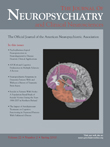ECT Treatment for Two Cases of Dementia-Related Aggressive Behavior
To the Editor: Behavioral problems in the form of agitation and physical aggression are common and very challenging sequelae of dementia. These symptoms are distressing to the patient and caregivers, disruptive to the home or nursing facility environment, and often lead to physical injury. The primary intervention for dementia-related behavioral agitation and aggression, after the failure of nonpharmacological measures, is judicious use of evidence-based medications including antidepressants, mood stabilizers, and atypical antipsychotics. 1 Unfortunately, there are few published controlled trials for these agents, and treatment with atypical antipsychotics has been shown to increase overall risk of mortality. 2 In addition, patients are often unable to tolerate the side effects of these medications. Thus alternatives to these treatment measures are frequently needed.
In a previous report, Bang et al. 3 reported two cases showing the effectiveness of ECT for dementia-related pathological yelling. While no controlled trials have been published, case reports indicate that ECT can be successfully utilized for severely adverse behaviors in the setting of dementia when other interventions have failed. 4 , 5 Here we report two cases of successful use of ECT after the failure of both nonpharmacological and pharmacological measures for patients diagnosed with dementia who developed the complications of severe agitation and aggression.
Case 1
“Mr. S” is a 78-year-old man with no known previous psychiatric history and a 5-year history of dementia of Alzheimer type. He was transferred to the medical psychiatry unit from a community nursing facility for evaluation and treatment of escalating behavior dyscontrol. He exhibited a 1-month history of worsening aggression in the form of grabbing and twisting his caregiver’s arms in a hostile manner. He actually injured four nursing home staff members. Therapeutic trials of sertraline, risperidone, olanzapine, intramuscular haloperidol, and valproate at the nursing home were ineffective.
His medications on admission included satolol, metformin, acetaminophen, trazodone, oxycodone, memantine, levothyroxine, tamsulosin, donepezil, allopurinol, simvastatin, and lisinopril. His neurocognitive examination demonstrated a jargon aphasia and global cognitive impairment. All lab work was within normal limits. Brain computerized tomography (CT) indicated diffuse cortical volume loss with secondary ventricular enlargement.
Electroconvulsive therapy treatment for his aggressive behavior was initiated. He received seven treatments with bitemporal lead placement. Seizure durations lasted up to 65 seconds. We noted obvious improvements in his aggression following the fourth ECT treatment. He did not show any untoward behaviors after the sixth ECT treatment and was very tolerant of staff assisting him with activities of daily living. The treatment was very well tolerated. He returned successfully to the nursing facility with no behavioral problems in the following 3 months while receiving maintenance ECT treatments extended to every 28 days.
Case 2
“Mr. J” is a 71-year-old man with no known past psychiatric history who had a 6-year history of frontotemporal dementia. In the preceding month, he began pushing, grabbing, and choking other residents and staff. On one occasion he threw a chair at a wall. There were no obvious precipitants to his episodes of aggression. He was described as irritable. Medical evaluation was negative. Trials of trazodone, quetiapine, sertraline, and topical lorazepam at his nursing home were ineffective or poorly tolerated.
His medications on admission included sertraline, pramipexole, thiamine, simvastatin, and acetaminophen. Memantine and donepezil were discontinued prior to admission due to poor tolerance. His neurocognitive evaluation on admission was limited by global aphasia. His language comprehension was impaired. Brain CT showed mild to moderate generalized cortical volume loss with secondary ventricular enlargement.
Electroconvulsive therapy treatment for his unprovoked aggression was started. He received six treatments with bitemporal lead placement. Seizure durations lasted up to 58 seconds. We noted improvements in his behavior following the fourth ECT treatment. His aggressive behaviors resolved after the sixth ECT treatment, and he was very cooperative and friendly with other patients and staff on the unit. He returned successfully to his nursing facility. He continues to receive maintenance ECT every 28 days with no subsequent psychiatric admissions.
Discussion
These two cases illustrate the effectiveness of ECT in treating medication refractory dementia-related aggression. In both cases, the ECT was well tolerated and led to marked improvement in social comportment and quality of life. The patients were discharged successfully to their residential facilities and received maintenance ECT, which remained effective. They were able to be weaned completely off of psychotropic medications.
Discerning the etiology of the behavioral changes in the setting of advanced dementia is difficult because agitation and aggression may be the result of impairment of cognitive functioning, psychosis, anxiety, mania, agitated depression, physical illness or discomfort, or a medication side effect. Although depressive disorders remain the most common indication for ECT in elderly persons, a growing literature identifies ECT as an effective intervention for severe refractory agitation and aggression for patients with dementia. 6 Based on these reports, we believe randomized, controlled trials with ECT are necessary to clearly delineate the effectiveness of ECT for these patients.
1. Tariot PN: Treatment of agitation in dementia. J Clin Psychiatry 1990; 60(suppl 8):11–18Google Scholar
2. Schneider LS, Dagerman KS, Insel MS: Risk of death with atypical antipsychotic drug treatment for dementia: meta-analysis of randomized placebo-controlled trials. JAMA 2005; 294:1934–1943Google Scholar
3. Bang J, Price D, Prentice G, et al: ECT treatment for two cases of dementia-related pathological yelling. J Neuropsychiatry Clin Neurosci 2008; 20:379–380Google Scholar
4. Holmberg S, Tariot PN, Challipalli R: Efficacy of ECT for agitation in dementia: a case report. Am J Geriatr Psychiatry 1996; 4:330–334Google Scholar
5. Wilkins KM, Ostroff R, Tampi RR: Efficacy of electroconvulsive therapy in the treatment of non-depressed psychiatric illness in elderly patients: a review of the literature. J Geriatr Psychiatry Neurol 2008; 21:3–11Google Scholar
6. Grant JE, Mohan SN: Treatment of agitation and aggression in four demented patients using ECT. J ECT 2001; 17:205–209Google Scholar



